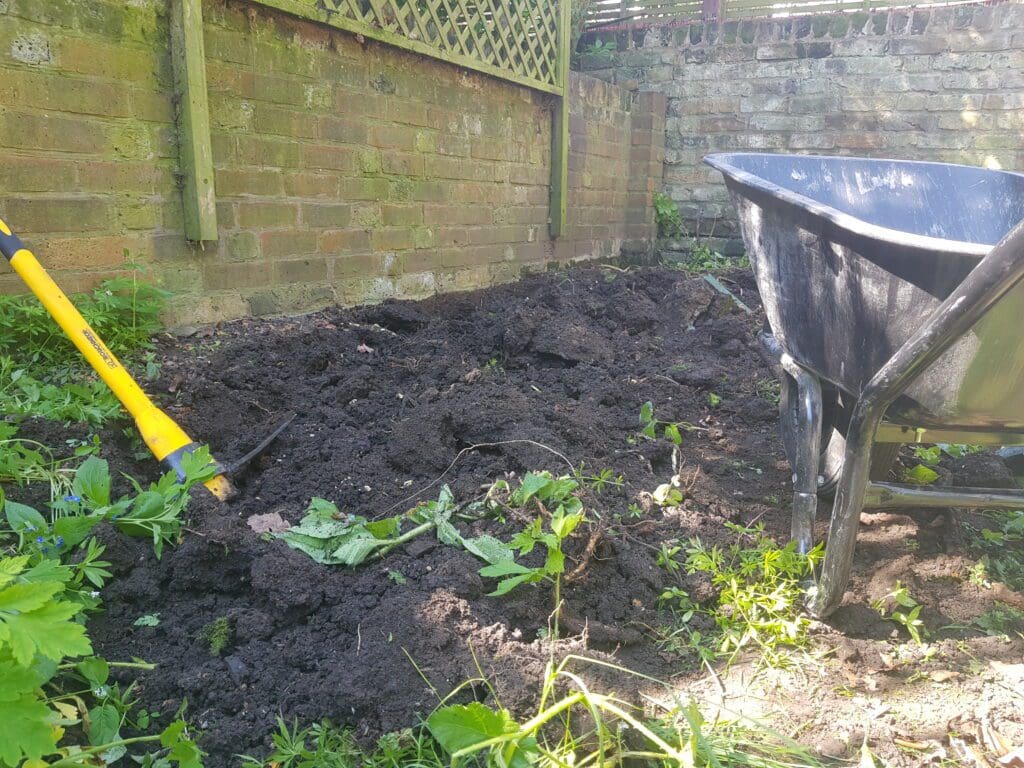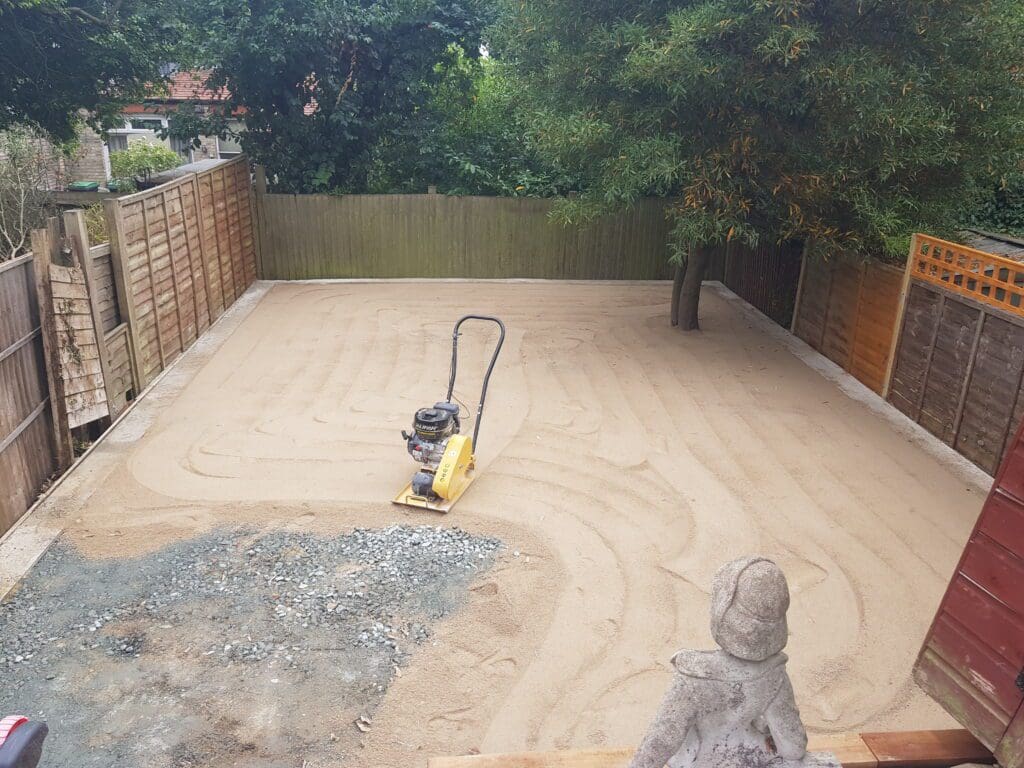Artificial grass isn’t the low-grade, rigid, bright-green turf it used to be. Today, we can use artificial turf for gardens, sports areas, and stadiums. It’s becoming more popular thanks to its low maintenance and realistic, natural appearance. Our helpful blog will guide you through all the steps of removing your old turf and replacing it with artificial grass!

How to Install Artificial Grass Step By Step
1. Remove Your Turf
There are a few ways to remove sod, depending on the thickness and composition of your lawn and the soil underneath. You can lift it manually, sliding a shovel underneath and pulling it up. To make things easier, you can use turf instead. Sod cutters remove turf in neat, even strips. You can roll these strips up so you can get rid of them or you can relay them on another surface.
You need to remove at least two inches of turf for the best results. Once you have removed the sod, you can also clear any weeds and obstacles like large stones and bricks. When the area is ready, you can compact the ground using a compactor or our guide to laying fake grass.
2. Create an edge
If you don’t have a natural edge, like a wall or fence, you might need some edging. Lawn edging is easy to install, and there are loads of great styles and designs to choose from. You can find what suits your garden best, and place it around the perimeter or borders. Edging creates clean, crisp lines that look fantastic.
3. Form a base layer
You now need to create a solid base for your artificial turf. Builder’s sand, granite dust, or stone are all suitable. A base layer of stone or granite should be around 6mm deep. If you are using sand, don’t create a surface deeper than 20mm.
4. Level the base layer
It is vital to compact your base layer thoroughly. If you don’t, your artificial turf won’t sit level, which ruins the effect. An uneven surface can also cause drainage and subsidence problems further down the line. Again, use a wacker plate, garden roller, or timber to level the area.
5. Lay membrane protection
The last thing you want is for weeds or pests to penetrate under the artificial turf once you have fitted it to the ground. It’s a good idea to install a membrane on top of your base layer for that extra added protection. Overlap membrane joints by over 300mm and use gaffer tape to stick them down for the best results. Secure the layer into place using 4-inch galvanised steel nails. Place a nail around the perimeter every 0.75mm.
6. Placing down the artificial turf
Unlike natural grass, the blades on artificial turf have an angle and don’t stand straight up. The look of the grass changes depending on different angles. Roll the artificial turf out with the pile leaning towards the main viewpoint, whether that’s your house, patio, or summerhouse. Installing the turf this way results in the most natural look. As the pile is directional, every roll should face the same way. Once you have covered the whole surface, allow the turf to settle for at least three hours. It needs to settle to avoid any wrinkling or creasing.
7. Make joints & trim the edges
Join the different sections of turf together. If you’re joining rolls side by side, fold the edges back and apply to join tape to the surface underneath. Then, fold the turf back over and apply some pressure. If you’re joining rolls end to end, pull the edges back by about 300mm. Put the tape in place, and stick the section with the pile running away from the seam down first. Next, stick town the turf that has the pile running over the edge of the seam. Leave a 2mm – 3mm gap, as anything more or less can result in a poor seam.
You can cut off any excess with a craft knife. Make sure you don’t trim any blades, as that will result in a bad seam or edge. Always cut away from your body to avoid injury.
8. Pin the turf
As artificial grass doesn’t have any roots to take hold, you need to fix it. You should install pins along the edges; every 20 – 25cm should be the optimum distance. You may see where the pins are at first, but if you ruffle up these areas, it should make the turf look more natural.
Compact the base for the artificial turf
The next step in the installation of your fake turf is to create the perfect base. It’s best to use finely crushed rock as the base of your artificial turf.
Crushed rock can be found easily in most major hardware stores throughout London, and it costs about £30 per metre square.
Evenly spread the crushed rock base. You can use a rake to lay the sub-base as flat as possible.
After you feel like it’s good enough, it’s time for you to use a compactor to compact the base. A vibrating plate will be the best for the job.

3. Form a base layer
You now need to create a solid base for your artificial turf. Builder’s sand, granite dust, or stone are all suitable. A base layer of stone or granite should be around 6mm deep. If you are using sand, don’t create a surface deeper than 20mm.
4. Level the base layer
It is vital to compact your base layer thoroughly. If you don’t, your artificial turf won’t sit level, which ruins the effect. An uneven surface can also cause drainage and subsidence problems further down the line. Again, use a wacker plate, garden roller, or timber to level the area.
5. Lay membrane protection
The last thing you want is for weeds or pests to penetrate under the artificial turf once you have fitted it to the ground. It’s a good idea to install a membrane on top of your base layer for that extra added protection. Overlap membrane joints by over 300mm and use gaffer tape to stick them down for the best results. Secure the layer into place using 4-inch galvanised steel nails. Place a nail around the perimeter every 0.75mm.
6. Placing down the artificial turf
Unlike natural grass, the blades on artificial turf have an angle and don’t stand straight up. The look of the grass changes depending on different angles. Roll the artificial turf out with the pile leaning towards the main viewpoint, whether that’s your house, patio, or summerhouse. Installing the turf this way results in the most natural look. As the pile is directional, every roll should face the same way. Once you have covered the whole surface, allow the turf to settle for at least three hours. It needs to settle to avoid any wrinkling or creasing.
7. Make joints & trim the edges
Join the different sections of turf together. If you’re joining rolls side by side, fold the edges back and apply to join tape to the surface underneath. Then, fold the turf back over and apply some pressure. If you’re joining rolls end to end, pull the edges back by about 300mm. Put the tape in place, and stick the section with the pile running away from the seam down first. Next, stick town the turf that has the pile running over the edge of the seam. Leave a 2mm – 3mm gap, as anything more or less can result in a poor seam.
You can cut off any excess with a craft knife. Make sure you don’t trim any blades, as that will result in a bad seam or edge. Always cut away from your body to avoid injury.
8. Pin the turf
As artificial grass doesn’t have any roots to take hold, you need to fix it. You should install pins along the edges; every 20 – 25cm should be the optimum distance. You may see where the pins are at first, but if you ruffle up these areas, it should make the turf look more natural.
9. Apply sand
You can apply a kiln sand dressing to achieve the most natural finish. 6 – 8kg of sand per square metre should be just right. You can spread the sand throughout the turf just using a brush. As the pile can sometimes sit flat after being rolled up, brushing against the fibres can also liven it up
10. All year-round green garden
That’s that! You can now enjoy a space that has a lush look all year round! Artificial turf is almost maintenance-free, and it can last for years as long as you treat it well.



